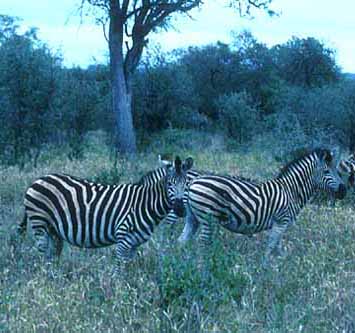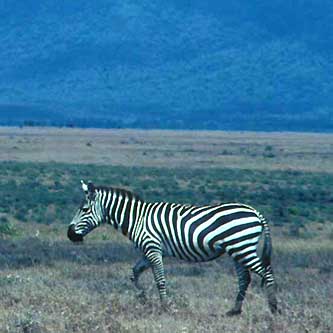

Kingdon (1997) recognizes five subspecies of Common Zebra (plus the extinct Quagga E. quagga; he considers it the same species as Common Zebra). There are very apparent differences between the zebras of east and central Africa E. b. boehmi (above and below right) and those in parts of southern Africa E. b. burchelli (below left). The latter, like these in Kruger National Park, have lighter brown counter-stripes interlineated between the broad black stripes over the rump and flanks, producing a more camouflaged pattern than those on the open plains.


 There
are two other species of zebra, both much rarer and limited in range. The
Grevy's
Zebra E. grevyi (right) has a larger head, more prominent ears
and mane, narrower stripes, and a crisp white belly. It once ranged throughout
the Horn of Africa in dry thornscrub but is now much decimated in Somalia
and Ethiopia, and only remnant populations remain in northern Kenya. This
photo was taken there in Samburu National Park.
There
are two other species of zebra, both much rarer and limited in range. The
Grevy's
Zebra E. grevyi (right) has a larger head, more prominent ears
and mane, narrower stripes, and a crisp white belly. It once ranged throughout
the Horn of Africa in dry thornscrub but is now much decimated in Somalia
and Ethiopia, and only remnant populations remain in northern Kenya. This
photo was taken there in Samburu National Park.
The final zebra is the Mountain Zebra E. zebra of southwestern Africa from Angola to the Cape region of South Africa. I have not yet seen this species. It lives in arid mountains and escarpments sufficiently close to the ocean to have mist and clouds (and thus water sources). In South Africa the species almost went extinct from hunting; it was officially protected as early as 1742 because it was so rare. A single farmer, Henry Lombard, saved 11 animals that lived on his farm at the species' low point in 1950. Today about 700 exist in six reserves, all descended from the 7 females of that stock.
I have never been much interested in horses, possibly because released ones that have formed feral herds in the American southwest have become a problem to native wildlife, fouling water sources used by Bighorn Sheep. But two wild asses (African E. africanus and Asiatic E. hemionus) live in remote desert country in North Africa and the Middle East, and Central Asia, respectively. The only one I know who has seen wild asses is Vladimir Dinets; a photo of African Wild Ass is on his website [on his "deserts" page with many other treats from flowers to lizards]. Both species are now very local and endangered. Regarding the various wild horses, Vladirmir writes:
Przhevalski's horse, now considered a subspecies of E. caballus, was recently (early 1990s) released in two nature reserves in Mongolia, apparently successfully. There were originally 2-6 more subspecies of E. caballus. The so-called forest tarpan (E. c. sylvaticus) is an ancestor of many primitive European breeds. By interbreeding them, a breed looking exactly like forest tarpan was created in the 1950s. It now lives in the wild in few nature reserves in Poland and Byelorussia. Recent studies have shown that it is practically identical to forest tarpan genetically.Literature: The taxonomy here follows Macdonald, D., ed. (1984) The Encyclopedia of Mammals, 1st ed. Facts on File Publ., New York. Other than personal experiences, the facts are mostly summarized from that text, or from Kingdon, J. (1997) The Kingdon Guide to African Mammals. Academic Press, London & New York.
The Kiang of Tibet is considered a species distinct from Asian Wild Ass by some (but I don't agree with that). Other subspecies include Mongolian (the most numerous), Iranian (mostly surviving in Turkmenistan and Kazakhstan), and Indian. Syrian subspecies is extinct, but wild asses of hybrid Syrian-Indian origin were reintroduced in Makhtesh Ramon in Israel, and now number about 200.
There were originally two subspecies of African Wild Ass, of which Nubian ass is now considered extinct. The only wild population is in Ethiopia.
PHOTOS: All photos on this page are © 2001 Don Roberson; all rights reserved. The Common Zebra at shots are from Samburu Nat'l Park, Kenya (top), Lake Bogoria, Kenya (3rd photo), both in Nov 1981, and Kruger Nat'l Park, South Africa, in July 1996 (2nd photo). The Grevy's Zebra was in Samburu Nat'l Park, Kenya, in Nov 1981.